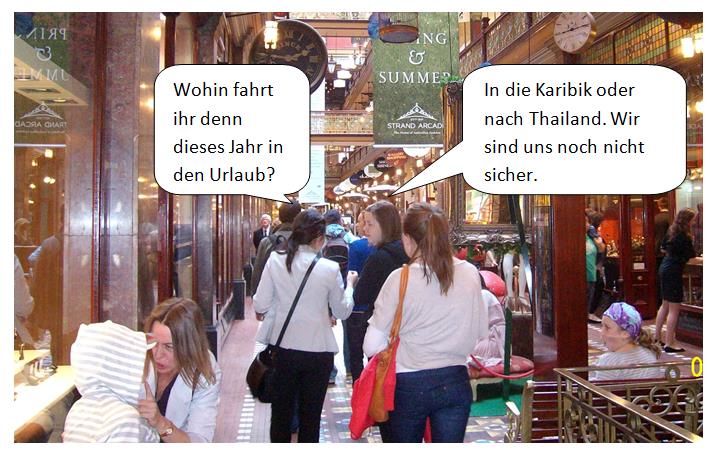In this lesson, you will learn about the different types of conjunctions in German. I will categorize them and explain which types of sentences they connect, as well as the placement of verbs within those sentences. Understanding the verb position is crucial in German grammar.
Thank you for reading this post, don't forget to subscribe!CONTENTS
Coordinating conjunctions (Konjunktionen)
Subordinating conjunctions (Subjunktionen)
Simple conjunctions
Complex conjunctions
Two-Part conjunctions
Using conjunctions
There are two main types of clause in German:
Coordinating conjunctions (Konjunktionen)
Subordinating conjunctions (Subjunktionen)
Click on:
Grammar Contents
Coordinating conjunctions (Konjunktionen)
The following are the most important coordinating CONJUNCTIONS in German. Most of them can link single words, phrases and clauses:
und (and), aber (but) , sondern (but), oder (or), denn (for,since)
Additionally, I have included two more conjunctions that are frequently used in spoken language:
sowie (and, as well as),
jedoch (however, but)
| COORDINATING CONJUNCTION | |||
| aber | but | nämlich | as, for |
| allein | but | oder | or |
| bald … bald | now … now | sondern | but |
| beziehungsweise | or | sowie | as well as |
| denn | as, for | sowohl … als | as well as |
| doch | but | teils … teils | partly … partly |
| entweder … oder | either … or | und | and |
| jedoch | but | weder … noch | neither … nor |
The function of independent conjunctions is to connect main clauses, dependent clauses of the same degree, and parts of sentences.
Examples:
main clause + main clause: Mia möchte ein neues Handy kaufen, aber sie hat kein Geld.
subordinating clause + subordinating clause: Ich habe gehört, dass er im Lotto gewonnen hat und dass er das ganze Geld gespendet hat.
part of sentence + part of sentence: Man kann die Wohnung mieten oder kaufen.
If you want to know more about Cordinating conjunctions click here.
“Denn” is a conjunction that translates to the English word “because.” However, unlike “because,” it is a coordinating conjunction that introduces a main clause, and it is important to note that a clause starting with “denn” cannot begin a sentence.
On the other hand, “sondern” and “aber” both translate to the English word “but,” and they need to be carefully distinguished.
“Sondern” is used specifically to contradict a preceding negative statement.
Additionally, the subject of the clause following “sondern” or “und” can be omitted (or understood) if it is the same as the subject of the first clause.
For example:
Mia kam um vier Uhr an und ging dann zu ihrer Oma. – Mia arrived at four and then went to her aunt’s.
Wir gingen nicht ins Kino, sondern blieben zu Hause. – We didn’t go to the cinema but stayed at home.
However, if a word or phrase is in front of the verb in the second clause, the SUBJECT must be repeated.
For example:
Mia räumte die Wohnung auf und dann ging sie zu ihrer Oma. – Mia tidied up the apartment and then went to her grandma’s.
Coordinating conjunctions most often link MAIN CLAUSES, with the verb in second position in both, as the examples given so far show. But they can also link two parallel SUBORDINATE CLAUSES (introduced by a subordinating conjunction). In this case the verb is in final position in both clauses.
For example:
- Ich hörte, dass er gestern einen Unfall hatte und dass er deswegen ins Krankenhaus gehen musste.
- Ich habe gehört, dass er gestern einen Unfall hatte und dass er deswegen in ein Krankenhaus eingeliefert werden musste.
– I heard that he had an accident yesterday and that he had to go to hospital because of it.
Subordinating conjunctions (Subjunktionen)
The following are the most important subordinating CONJUNCTIONS (Subjunktionen) in German:
weil (because), dass (that), wenn (if, when), obwohl (although), ohne dass (without that), als ob (as if), bevor (before),
The function of dependent conjunctions is to introduce dependent clauses that depend on a superordinate main or dependent clause.
Examples:
main clause + subordinating clause = Mia kommt heute nicht zur Arbeit, weil sie krank ist.
main clause + subordinating clause + subordinating clause = Der Chef hat mich gesagt, dass Mia heute nicht kommt, weil sie krank ist.
If you’d like to know more about Subordinating conjunctions, you can click here.
Forms of Conjunctions
Regarding their form, there are simple, complex and two-part conjunctions.
Let’s see which conjunctions fall into which category:
SIMPLE CONJUNCTIONS
aber (but), bis (until), denn (because), insofern (in so far as), obgleich (although), solange (as long as), doch (but, but still), seitdem (since), und (and), wie (as), als (than), sondern (but), beziehungsweise (respectively), während (while), sooft (whenever,every time), da (as, since), falls (if) …
COMPLEX CONJUNCTIONS
als dass (as if), statt dass (instead of that), als ob (as if), selbst wenn (even if), je nachdem (depending on), auch wenn (even if), selbst wenn (even if), anstatt dass (instead of that), ohne dass (without that) …
TWO-PART CONJUNCTIONS
entweder – oder (either – or), sowohl – als auch (both – and), je – desto (the – the), sowohl – wie auch (both … and, – as well as), nicht nur – sondern auch (not only – but also), weder – noch (neither – nor)
If you want to know more about Two-Part Conjunctions click here.
Conjunctions that introduce infinitive sentences:
als … zu, anstatt … zu, ohne … zu, statt … zu, um … zu…
Click on:
Grammar Contents
Using Conjunctions
The task of conjunctions is to connect clauses (or parts of sentences) with each other. Coordinating conjunctions are different from Subordinating and now we will see how they differ.
Subordinating conjunctions connect main clauses, parts of sentences, and subordinating clauses that depend on the same main clause
Main clause:
Example:

Subordinating clause:
Example:

Parts of the sentence:
Example:

A subordinating conjunctions connects a subordinating clause with a superordinate main or dependent clause.
Example with a superordinate main clause:

With a superordinate dependent clause:

Example:
If you want to know more about Coordinating Conjunctions click here
If you want to know more about Subordinating Conjunctions click here
If you want to know more about Two-Part Conjunctions click here
See more:

